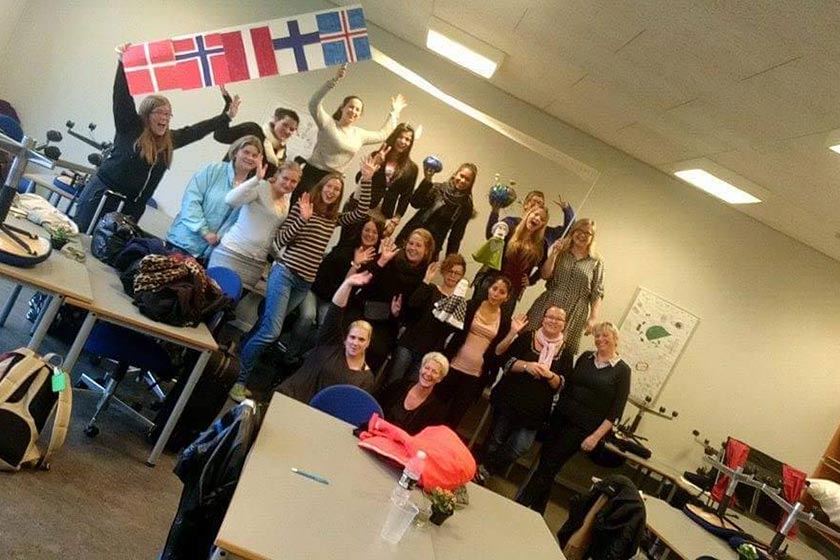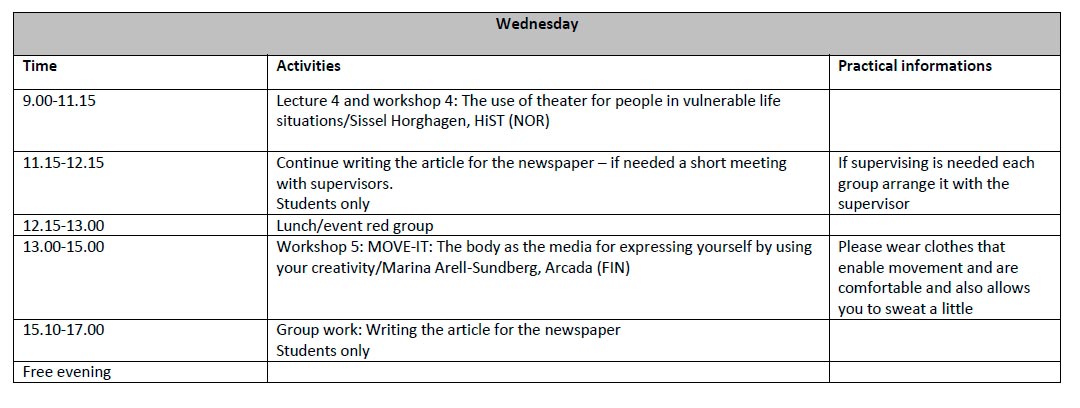
Authors: Marina Arell-Sundberg, Sissel Horghagen, Tania Hansen, Camilla Pyndt.
Introduction
The network ‘Occupational Therapy in Nordic and Baltic Countries’ was established in 1992 and is a network under Nordplus Higher Education Programme (Nordplus). It is represented by the Nordic countries; Denmark, Finland, Iceland, Latvia, Lithuania, Norway and Sweden. The participating universities take turns to coordinate the collaboration in the network. The aim of the network is to increase student and teacher mobility and increase the collaboration between occupational therapy educations in the Nordic and Baltic countries. The network also works to reach high quality education and development through mobility, supportive relations and cooperation between the partner institutions. An overall aim is to create a unanimous knowledge base in regards to occupational therapy education, praxis and development within the collaborating universities in the member countries. The biggest effort has been in organizing an intensive course: “Creativity as a means in occupational therapy”. It has been developed through mutual planning and it fits into the curriculum of all partners, which is very important since all partners don’t have the possibility to send out students for longer exchange periods.
Description of the course
Through using self-experiences and third person perspective pedagogic approaches, the purpose of the course has been to enhance students’ own insight and evidence-based knowledge about relations between creative activities and health from a diversity viewpoint (including cultural traditions, communication and creative crafts). Students have been introduced to different perspectives on creative occupations. The benefits of participating in creative occupations and its relation to health and wellness have been identified. The occupational therapist uses creative activity, but also uses any activity in a creative way so therefore the creative design process is essential for occupational therapists. Pierce (2003) writes about building therapeutic power and in order for this to happen there needs to be creative thinking. Using individual or group interventions in creative activities, gives a flexibility that from the clients own perspective have great benefits from both a personal enhancement and developmental aspect (Pierce 2003; Horghagen; 2014).
Through evidence-based knowledge, experience and observation, the students have analysed demands and possibilities in activities with a focus on enablement through creativity. The students have practiced methods to explore the use of creative occupations and propose ideas related to health and occupational therapy intervention. They have explored their own creativity and learned about creativity in groups, and cultural diversity perspectives.
The learning outcomes of the course are about students knowing the conceptual foundations of creativity as used within occupational therapy and about the value of various creative activities for participation in occupation, health and wellbeing. They are also about how to identify oneself as a member of a group and how to gain a wider knowledge on diverse ways to express oneself and communicate through creative means.
The form of the course
Through the three last years the intensive course has been carried out in Finland, Latvia and Denmark. The pedagogic methods used in the course have been self-studies, lessons, workshops, group-work and presentations of group-work (Wlodkowski & Ginsberg 2010: 1-8). The students have been working in international teams throughout the course. Totally about 90 and approximately 30 students from the different countries have participated each year.
The involved teachers, in an average 4 on every course, have been cooperating with the planning, the implementation of the course, and the examination of the students. The planning has followed the 7 strategies as presented by Wlodkowski & Ginsberg (2010: 52-68):
- To allow for all to get to know each other and introduce themselves
- To provide multidimensional opportunities for sharing
- To concretely show what is expected of the participant before, under and at the end of the week.
- To use collaborative and cooperative learning experiences
- To present clear and concrete learning objectives and goals
- To show the connection between what has been learned and how it can be used within Occupational Therapy practice.
- To assess every students learning process in a graspable way
The three critical elements of cultural competence Understanding and awareness of one´s own cultural values and biases, knowledge and information of history, perspectives and values of culturally different groups and how to adapt one´s behaviour and skills to successfully interact with one another during the week, has guided the planning of the content of the week (Wlodkowski & Ginsberg 2010:48). The students also had literature to read as a preparation and exercises to present in the beginning of the course (Wlodkowski & Ginsberg 2010: 9). The course has the following issues: Lessons about creative activities and about fantasy, ideas and innovation as well as workshops on the topics. The students have received 2 ECTS; based on participation and presentation. The course content has been distributed though the network and has only been available to the members within the network. All member universities have access to all material through a mutual cloud service. Following an example of one of the days during the intensive Course in Denmark 2015:

The examination has been both oral and written. In groups, students have written reports of their work. The reports have been structured differently: both as a scientific paper (introduction, aim, method, results, and discussion) and as an article for a newspaper. The examination has also been about presenting therapeutic use of creative activities for a defined group. The evaluation of the assignments has its core in the aims of the course and has been carried out by using peer review.
Experiences with the course
The feedback and the experiences of the course where gathered though both a questionnaire and a group discussion. The students got information about the usage of both the content of the questionnaire and the discussions for this article, and they all gave their consent.
Theoretical reasoning and practical skills for therapeutically use of creative activities
The students developed understanding of the reasoning of using creative activities in occupational therapy practice and achieved knowledge about creative activities. Students also expressed that they developed skills in applying creative activities; they learned tools and techniques from lectures, but also skills in the arranged workshops. Related to one of the oral evaluations a student expressed: “Through the lectures I have learned to think out of the box and the word “creativity” now has a new and wider meaning”.
Developing cultural sensitivity and awareness
Students also experienced and reflected on how they have developed as human beings, as well as occupational therapists, through participating in the course. The most unexpected event was how the students described their growth in cultural sensitivity and awareness. Through that awareness, every student’s personal recognition of him/herself as a creative occupational therapist has also grown. Through the group-works, they reflected upon their own culture and other participants’ culture. We assume that the duration of the course, it lasted a week, was a factor for making this possible – they became familiar and comfortable with each other.
Participation in creative activities contributed to personal development
The students described a discovery of themselves as creative occupational therapists by being creative in different innovative ways. This implies an understanding of a therapeutic use of self within the creative activities. This has been two-fold, they have seen how people can develop their potential through creative activities, and they have experienced that they developed as human and therapist through participation in the course. This personal development was something that we had not expected to emerge. It was new to us, that the students expressed their experiences of personal development to such an evident extent. In a course like this, students get an international competence that enriches both education and practice in the students’ homelands.
Reflection
There is a discussion and further challenge to make foundations of creative activities in the theories of activity in the profession. A course like this can contribute to building that foundation. The evaluations also underline a new learning outcome; namely, how the students experience and develop self-development for their future professional role as occupational therapists, plus in cultural awareness and sensitivity. Students as well as the teachers participating and arranging the course, get an international competence that enriches both education and practice in their homelands. This aspect contributes to an internationalisation of higher education.
Authors
Marina Arell-Sundberg, Senior lecturer, MA. in Rehab, OTR, Arcada University of Applied Siences Helsinki Finland, arellsum(at)arcada.fi
Sissel Horghagen, Principal lecturer, Ph.D., OTR, Norwegian University of Science and Technology, Trondheim Norway, sissel.horghagen(at)ntnu.no
Tania Hansen, Senior lecturer, MA (Ed) in Educational Anthropology, OTR, University College Sjælland, Næstved, Denmark, taha(at)ucsj.dk
Camilla Pyndt, Senior lecturer, MA in Heath Services, OTR, University College Sjælland, Næstved, Denmark, cpy(at)ucsj.dk
[vc_tta_accordion active_section=”0″ no_fill=”true” el_class=”lahteet”][vc_tta_section title=”References” tab_id=”1458134585005-b3f22396-5506″]
Erasmus (2016). Erasmus+. Programme guide. Version 2(2016):07/01/2016
Horghagen, S., Fostvedt, B., & Alsaker, S. (2014). Craft activities in groups at meeting places: supporting mental health users’ everyday occupations. Scandinavian Journal of Occupational Therapy, 21(2), 145-152.
Pierce, D. E., & Pierce, D. (2003). Occupation by design: Building therapeutic power. FA Davis company.
Wlodkowski, R.J. & Ginsberg. M.B. (2010). Teaching Intensive an Accelerated Courses: Instruction that Motivates Learning. San Francisco: John Wiley & Sons.
[/vc_tta_section][/vc_tta_accordion]



